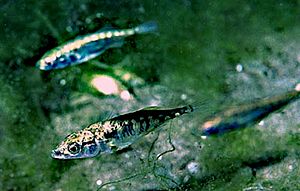Gasterosteiformes facts for kids
Quick facts for kids Gasterosteiformes |
|
|---|---|
 |
|
| Three-spined sticklebacks, Gasterosteus aculeatus | |
| Scientific classification |
|
| Kingdom: | Animalia |
| Phylum: | Chordata |
| Class: | Actinopterygii |
| Superorder: | Acanthopterygii |
| Order: | Gasterosteiformes |
| Type species | |
| Gasterosteus aculeatus Linnaeus, 1758
|
|
| Families | |
|
Aulorhynchidae |
|
Gasterosteiformes is a group, or order, of ray-finned fishes. This order includes well-known fish like the sticklebacks and their close relatives.
The name "Gasterosteiformes" tells us something special about these fish. It comes from Ancient Greek words: gaster (meaning "stomach" or "abdomen") and ostoun (meaning "bone"). So, the name means "bone-bellies." The ending "-formes" is from Latin and means "of similar form," which is common for fish orders.
Contents
What Makes Gasterosteiformes Special?
These fish have some unique features. Their body is often partly or completely covered with special dermal plates, which are like bony armor.
Also, their pelvic bones are not directly connected to their shoulder bones (called cleithra). Some other bones, like the supramaxillary, orbitosphenoid, and basisphenoid bones, are also missing in these fish.
The Gasterosteiformes Family Tree
Scientists study how different groups of animals are related. For a long time, the Gasterosteiformes group included fish like sea horses and pipefishes. These were placed in a suborder called Syngnathoidei. The sticklebacks and their relatives were in another suborder called Gasterosteoidei.
However, many newer studies suggest that sea horses and pipefishes are actually part of a different order called Syngnathiformes. It seems these two groups are not as closely related as once thought.
Scientists are still working to understand the exact family tree of these fish. It appears that the Gasterosteiformes are closely related to another group of fish called Scorpaeniformes, which includes scorpionfishes. Some fish, like the flying gurnards, which look a bit like scorpionfish, might actually belong with the sea horses and pipefishes!
The closest living relatives of the Gasterosteiformes seem to be the gunnels and eelpouts (Zoarcidae). These fish are usually placed in a very large group called "Perciformes". It looks like gunnels and eelpouts might have evolved from the same ancestors as Gasterosteiformes and Scorpaeniformes, but they lost the bony armor that their relatives have.
Main Families in Gasterosteiformes
There are three main families that are definitely part of the Gasterosteiformes order:
- Aulorhynchidae – These are known as tube-snouts.
- Gasterosteidae – This family includes the well-known sticklebacks.
- Hypoptychidae – These fish are called sand eels.
Other fish, like the armored sticklebacks (Indostomidae) and the dragonfishes and sea moths (Pegasidae), are sometimes placed with either the pipefish group or the stickleback group. Most scientists now agree that Pegasidae belong with the Syngnathiformes (sea horses and pipefishes). The exact place for the Indostomidae family is still being discussed.
Fish Through Time
The timeline below shows when different types of Gasterosteiformes fish (or their close relatives) first appeared in history, based on fossil records.

See also
 In Spanish: Gasterosteiformes para niños
In Spanish: Gasterosteiformes para niños

